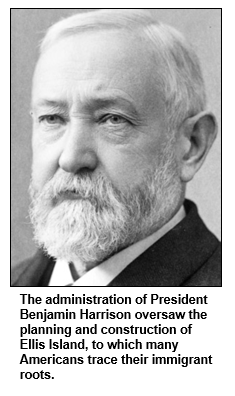Jun 19, 2020
|
Saturdays, noon to 1 p.m. ET on WICR 88.7 FM. |
|
June 13, 2020 Ellis Island, immigration and Indiana: encoreClick here to listen to the podcast.
The receiving station for aspiring Americans now celebrated as an iconic aspect of our shared history opened on Ellis Island in 1892 during the administration of President Benjamin Harrison, so the only president elected from Indiana oversaw the lead-up to its debut. According to some estimates, about 22 million immigrants passed through Ellis Island during the years between 1892 and 1924, its peak period as the country's "door." (Ellis Island remained open as a receiving center until 1954, but during its final 30 years, limitations on immigration - and the creation of other points of entry - meant that far fewer immigrants were handled at the island.) Not only will we explore the challenges that confronted all involved during the early Ellis Island years - immigrants often endured shockingly crude medical exams - we also will look at the waves of ethnic heritage groups that came to Indiana from the 1890s through the mid-1920s. Nelson's studio guests are:
During our show, we will frame the early decades of immigration through Ellis Island by describing the waves of ethnic immigration to Indiana that preceded it, including early Irish, German, English and Scottish arrivals. Between the 1890s and the start of World War I in 1914, many waves of immigrants came from what then was the Austro-Hungarian Empire; today, after more than a century of geopolitical shifts and cartographic reconfiguration, their countries of ancestral origin are the modern nations of Hungary, Austria, Ukraine, Belarus, Poland and Slovakia.
Italian immigration during the late 19th and early 20th centuries included hundreds of marble-cutters who settled in southern Indiana, including the town of Bedford, to work as limestone carvers. Hoosier History Live explored this aspect of Italian immigration in 2010. Other shows that explored immigration to Indiana during the heyday of Ellis Island include our programs about Latvian and Lithuanian heritage in 2016 and Russian immigration in 2014. Our guest Jennifer Capps will share details about crude eye examinations - with unsterilized equipment - that were imposed on immigrants during the early decades of Ellis Island as a receiving station. Federal laws called for the rejection of those who showed indications of suffering from a "loathsome or contagious disease," but the reality was that many immigrants were turned away if they displayed any hint of illness or physical impairment, according to Ellis Island Interviews: In Their Own Words (Checkmark Books, 1997). A fire at Ellis Island burned the first receiving station to the ground in June 1897, more than four years after Harrison's presidency ended. By then, more than 1.64 million immigrants had been processed. The fire destroyed immigrant records from 1855 to 1897, including those from Castle Garden. About 200 immigrants were on the island at the time of the inferno, but all were safely evacuated. Construction began immediately of new buildings made of materials deemed fireproof. Some history facts:
|

 Ellis
Island
Ellis
Island According to
timelines in Teresa's books and in other reference sources, the
1890s through the early 1900s in Indiana was an era of heavy
immigration from Eastern European countries including Poland,
Hungary and Russia, as well as such Mediterranean countries as
Greece and Italy. Significant percentages of the immigrants were
Catholic and Jewish.
According to
timelines in Teresa's books and in other reference sources, the
1890s through the early 1900s in Indiana was an era of heavy
immigration from Eastern European countries including Poland,
Hungary and Russia, as well as such Mediterranean countries as
Greece and Italy. Significant percentages of the immigrants were
Catholic and Jewish. According
to
According
to